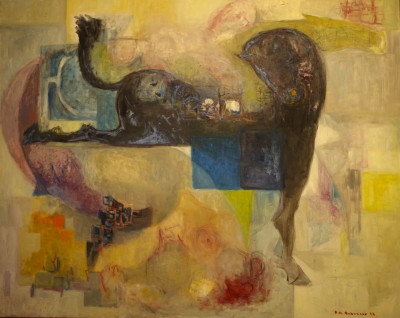HÉLÈNE DE BEAUVOIR
biography
As early as 1961, Hanna Bekker vom Rath exhibited the French painter Hélène de Beauvoir (1910-2001) - making her the first gallery in Germany to do so. Paintings by the artist are now in the Musée de la Moderne, Paris, and museums in Pittsburgh, Regensburg, Strasbourg and Lausanne.
Hélène de Beauvoir began her artistic training at the end of the 1920s at the Paris art academies Colarossi, Grande Chaumière, Académie Scandinave and the École d'Art et Publicité. At the time, she belonged to the circle around her sister Simone and Jean-Paul Sartre. Her sister, who was two years older and had a permanent job as a teacher, paid for her studio. In return, Hélène typed Simone's and Jean-Paul Sartre's manuscripts. She is often quoted as having met Picasso, who praised the "independence" of her painting when he visited her first solo exhibition at the Bonjean Gallery in Paris in 1936. Early trips took her to Spain and to the major art collections in Italy. In 1942, Hélène married the cultural attaché Lionel de Roulet, a former student of Sartre's whom she had met in 1933. From then on, she led a "bourgeois" life with him, which earned her critical comments from her sister. This was followed by moves to Vienna, Belgrade, Casablanca, Milan and, via Paris, finally to Goxwiller in Alsace in 1963, where she lived until her death. She exhibited worldwide in the 1970s, including in Tokyo, Boston and New York. In 1983, she gave a lecture in Philadelphia on "The role of women in society using the example of the female painter". Until 1983, she was president of the Flora Tristan Center for abused women and young people, which was founded in 1978.
Hélène de Beauvoir, who said that she was a feminist long before her sister, was committed to women's rights, social discrimination and environmental issues. This also provided her with motifs for her paintings. She also created landscapes, which are mostly animated by objects or people, but also graphic series such as a series of woodcuts on Oscar Wilde's "The Selfish Giant" in 1928. In her work, the artist engaged with the art movements of the 20th century, with cubism and abstraction, with the orphism founded by Robert Delaunay, whose circular forms dissolve into crystalline facets of the pictorial inventory in Beauvoir's work. The interplay of different painting styles in the pictures of the late sixties and seventies seems surprisingly topical today.

